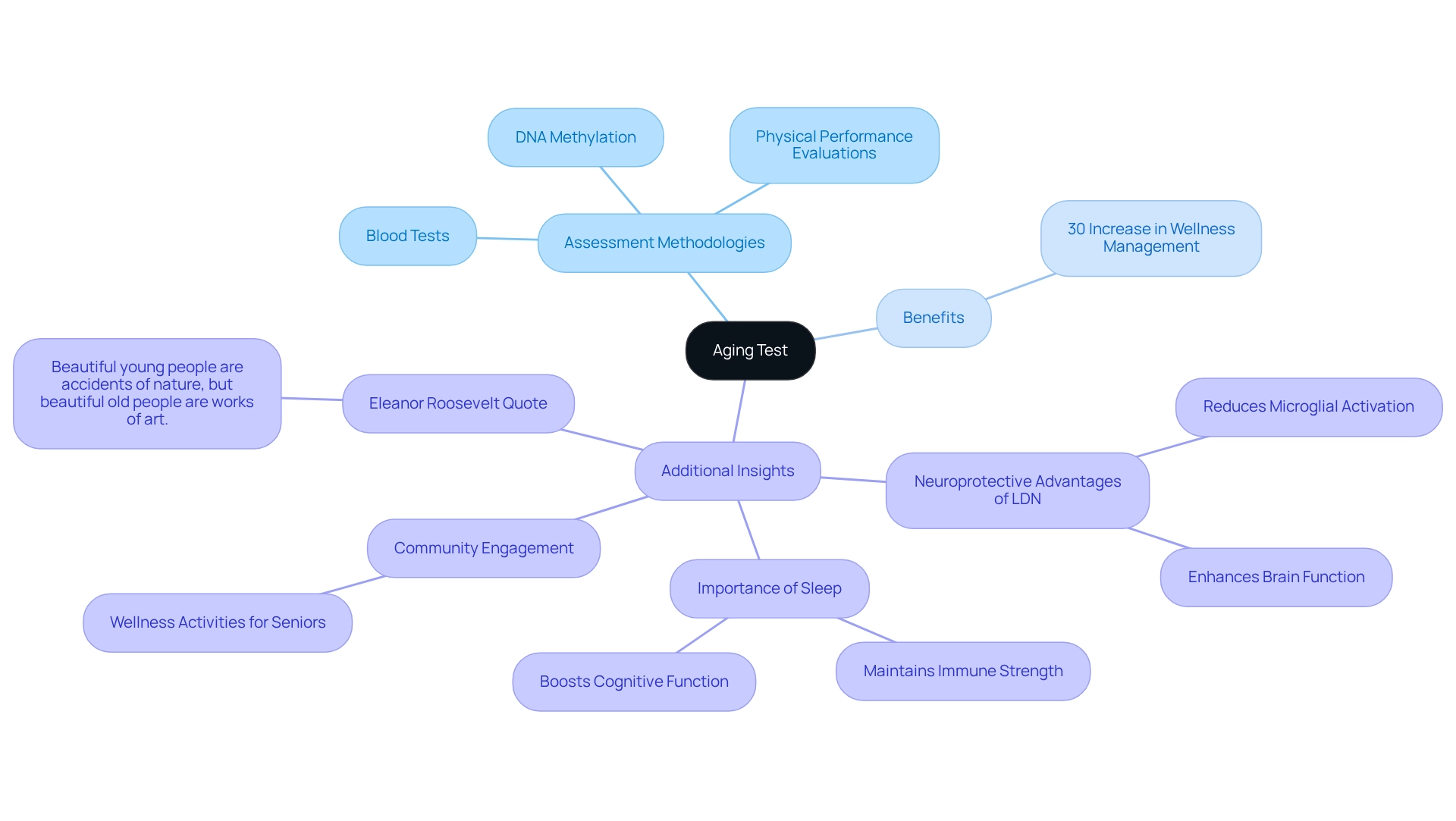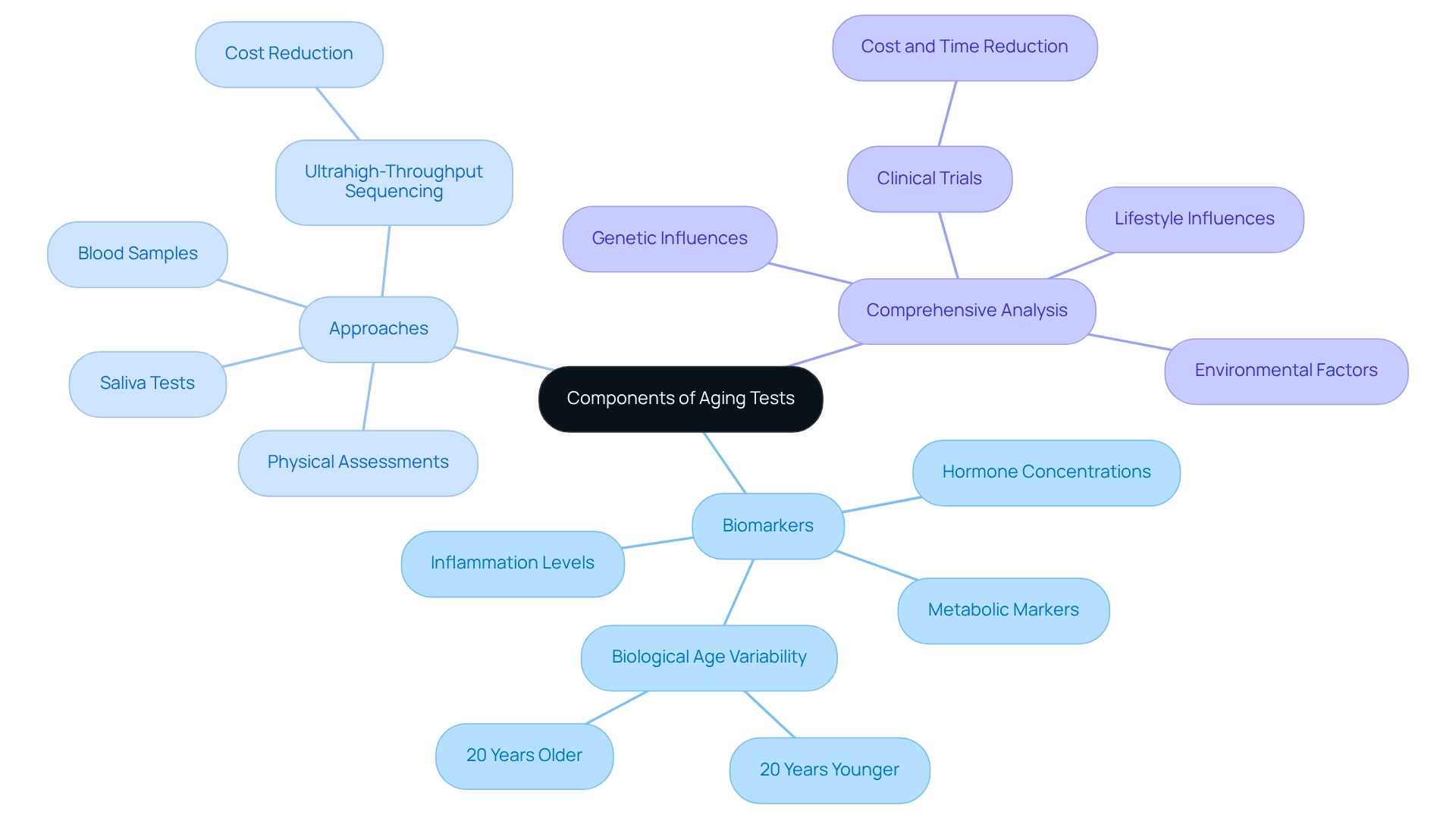Aging Test: Understanding Its Importance, Origins, and Key Features
Overview
Aging tests play a vital role in understanding biological age and overall health. They employ various methodologies, including blood tests, DNA analysis, and physical evaluations, to assess an individual’s physiological state. Have you ever wondered how these assessments can impact your life? Not only do they identify risks for age-related illnesses, but they also empower individuals to make informed lifestyle choices. By understanding their biological age, people can enhance their longevity and well-being. In conclusion, embracing aging tests can be a transformative step towards a healthier future.
Introduction
As society grapples with the complexities of aging, the quest for understanding biological age has taken center stage. Aging tests, which assess a range of biomarkers, are emerging as essential tools for individuals seeking to navigate their health journeys with greater insight and precision. These evaluations not only reveal discrepancies between biological and chronological age but also empower proactive health management, potentially reducing risks associated with age-related diseases.
With advancements in technology and a growing emphasis on holistic wellness, the landscape of aging tests is evolving. This evolution promises to reshape how individuals approach longevity and vitality. From innovative methodologies to the implications of lifestyle choices, the conversation around aging tests is rich with possibilities. These developments could redefine healthy aging for generations to come.
Define Aging Test: A Comprehensive Overview
An aging test encompasses various assessments aimed at determining biological age, which can significantly differ from chronological age. These assessments typically include an aging test that examines diverse biomarkers reflecting a person’s physiological condition, providing valuable insights into their overall well-being and potential for longevity. Recent data indicates that individuals who engage in regular aging tests can identify risks earlier, leading to a 30% increase in proactive wellness management. Common methodologies include:
- Blood tests that assess specific biomarkers
- DNA methylation analysis
- Physical performance evaluations
Notably, the neuroprotective advantages of Low Dose Naltrexone (LDN) have surfaced as a key area of interest, particularly regarding its potential in addressing neurodegenerative diseases and mood disorders. LDN’s ability to reduce microglial activation may enhance brain function, which is crucial as we age. Additionally, the essential role of sleep in boosting cognitive function and overall well-being cannot be overlooked; quality sleep is vital for maintaining immune strength and physical health.
As Eleanor Roosevelt once remarked, ‘Beautiful young people are accidents of nature, but beautiful old people are works of art.’ This quote resonates with the idea that understanding our aging process can lead to a more graceful and informed approach to well-being. The outcomes of these aging tests empower individuals to understand their unique aging journeys and make informed lifestyle choices that promote healthier aging. Furthermore, ByKomi.com offers numerous events aimed at engaging seniors in wellness activities, further supporting the community in their pursuit of improved well-being.

Contextualize Aging Tests: Their Role in Longevity and Health
Aging tests are essential in the domain of longevity and wellness, providing individuals with vital insights into their biological age and overall condition. As the worldwide population continues to grow older, understanding the factors of healthy aging becomes crucial. These assessments can identify risk factors for age-associated illnesses, allowing for prompt actions that can significantly influence wellness paths.
For instance, evaluations that assess inflammation indicators and metabolic health offer important information that can guide dietary and lifestyle changes aimed at improving longevity, and recent trends indicate a growing embrace of aging tests, signifying a movement toward proactive wellness management. A considerable segment of healthcare information now exists beyond conventional medical establishments, highlighting the necessity of accessible testing options for individuals looking to track their well-being. This shift in healthcare underscores the importance of training physicians and integrating longevity principles into medical programs to promote longevity medicine, ensuring that healthcare providers are equipped to assist patients in their wellness journeys.
Insights from innovative studies, such as Dr. Dituri’s comprehensive research on telomere length and physiological responses to underwater environments, emphasize the potential for unique interventions to influence the aging process. Moreover, the longevity of the Hunza people, who thrive on a nutrient-dense diet and strong social connections, demonstrates the significant impact of cultural practices and nutrition on health outcomes. This perspective encourages individuals to embrace aging with optimism, fostering growth and vitality in later years, which aligns with ByKomi.com’s advocacy for a proactive approach to wellness management.
Furthermore, assessments for older adults not only identify risk factors for age-associated illnesses but also play a critical role in preventing these issues. ByKomi.com supports the integration of aging tests into a comprehensive wellness strategy, emphasizing nutrition and cutting-edge treatments. This holistic approach empowers individuals to take charge of their wellness journey, promoting a proactive attitude toward aging with grace and vitality.
Trace the Origins: Evolution of Aging Tests in Scientific Research
The development of aging tests has its origins in early gerontology, where researchers sought to uncover the biological mechanisms of senescence. Initially, these studies relied on basic physiological measurements, such as heart rate and blood pressure, to gauge health status. However, significant advancements in molecular biology and genetics have revolutionized the aging test field. The introduction of biomarkers, including telomere length and DNA methylation patterns, has enabled more precise evaluations of biological age through an aging test, moving beyond mere chronological age. Recent developments have further refined these assessments, leveraging machine learning and advanced analytics to improve predictive capabilities. For example, modern research employs extensive data sets to examine patterns of growing older, demonstrating that biological maturation is a cumulative process, as verified by longitudinal studies of senior populations. This is particularly relevant considering that the average lifespan of the American population is now estimated to be about 97 years, emphasizing the significance of understanding the dynamics of growing older.
Moreover, insights from the anti-aging community, including the benefits of a carnivore diet and innovative therapies like Low-Dose Naltrexone (LDN), emphasize the role of quality nutrition and scientific innovations in promoting longevity. The historical context of therapies for the elderly, as mentioned by Serge Voronoff, who asserted that ‘transplantation of sex glands provides more durable effects than injection of a suspension of ground glands,’ highlights the intricate nature of growing older and the necessity for sophisticated tools to accurately measure it. This evolution paves the way for innovative approaches in well-being, as explored through personal experiences and scientific insights shared on ByKomi.com.
Identify Key Characteristics: Components of Aging Tests
Essential features of efficient aging tests lie in their capacity to evaluate various biomarkers that reflect the physiological changes associated with senescence. These assessments typically encompass several critical elements:
- Biomarkers: These quantifiable indicators of biological processes include inflammation levels, hormone concentrations, and metabolic markers, which provide insights into an individual’s well-being. Notably, biological age values can differ by as much as 20 years younger or 20 years older than a person’s chronological age, underscoring the variability in aging evaluations. ByKomi.com emphasizes the importance of integrating dietary and lifestyle factors into aging test evaluations, promoting a holistic view of wellness that supports longevity and vitality.
- Approaches: Aging tests utilize diverse methodologies, such as blood samples, saliva, or physical assessments, to gather comprehensive data on an individual’s biological state. The advent of ultrahigh-throughput sequencing technologies is expected to further reduce costs associated with biomarker applications, enhancing the accessibility of these assessments. This aligns with ByKomi.com’s commitment to innovative therapies that foster well-being and longevity, emphasizing the role of aging tests which offer predictive validity by correlating with wellness outcomes and providing critical insights into potential risks for age-related diseases. For example, biochemistry-based biological clocks have been developed using various blood parameters, demonstrating their potential in predicting health outcomes such as mortality and hospitalization risk. This highlights the importance of predictive validity in understanding the aging process, a focal point for ByKomi.com, especially regarding the aging test.
- Comprehensive Analysis: The most effective aging tests consider a wide array of factors, including genetic, environmental, and lifestyle influences on the aging process. This multifaceted approach is vital for grasping the complexities of the aging test and tailoring interventions accordingly. As Jing-Dong Jackie Han from the Peking-Tsinghua Center for Life Sciences notes, the inclusion of biomarkers in assessments of senescence is crucial for enhancing our understanding of health outcomes. Moreover, utilizing biomarkers in clinical trials may reduce the cost and duration of drug discovery for aging-related diseases, emphasizing their essential role in aging research.

Conclusion
The exploration of aging tests reveals their transformative potential in understanding biological age and enhancing health management. By measuring a variety of biomarkers, these tests provide crucial insights that can lead to proactive health interventions, allowing individuals to identify risks associated with age-related diseases early on. With methodologies ranging from blood tests to DNA analysis, advancements in aging assessments underscore the importance of integrating knowledge about biological aging into everyday health practices.
As society moves towards a more proactive approach to health, the role of aging tests becomes increasingly significant. They not only empower individuals to make informed lifestyle choices but also highlight the need for a holistic view of health that encompasses nutrition, physical activity, and mental well-being. The emphasis on personalized health strategies, supported by organizations like ByKomi.com, encourages a positive perspective on aging, promoting vitality and longevity.
In light of ongoing advancements in scientific research and technology, the evolution of aging tests marks a pivotal point in the conversation around healthy aging. As these tools become more accessible and widely adopted, they pave the way for a future where individuals can take charge of their health, ultimately fostering a culture that values informed aging and well-being. The insights gained from aging tests hold the promise of redefining our understanding of longevity, enabling individuals to age gracefully and with purpose.
Frequently Asked Questions
What is an aging test?
An aging test encompasses various assessments aimed at determining biological age, which can significantly differ from chronological age. These assessments examine diverse biomarkers reflecting a person’s physiological condition, providing insights into their overall well-being and potential for longevity.
What are the benefits of engaging in regular aging tests?
Individuals who engage in regular aging tests can identify risks earlier, leading to a 30% increase in proactive wellness management.
What methodologies are commonly used in aging tests?
Common methodologies include blood tests that assess specific biomarkers, DNA methylation analysis, and physical performance evaluations.
How does Low Dose Naltrexone (LDN) relate to aging?
LDN has neuroprotective advantages and is of interest for its potential in addressing neurodegenerative diseases and mood disorders. It may enhance brain function by reducing microglial activation, which is crucial as we age.
What role does sleep play in the aging process?
Quality sleep is vital for maintaining cognitive function, immune strength, and overall physical health, making it essential for healthy aging.
How can aging tests empower individuals?
The outcomes of aging tests empower individuals to understand their unique aging journeys and make informed lifestyle choices that promote healthier aging.
What resources does ByKomi.com offer for seniors?
ByKomi.com offers numerous events aimed at engaging seniors in wellness activities, supporting the community in their pursuit of improved well-being.






